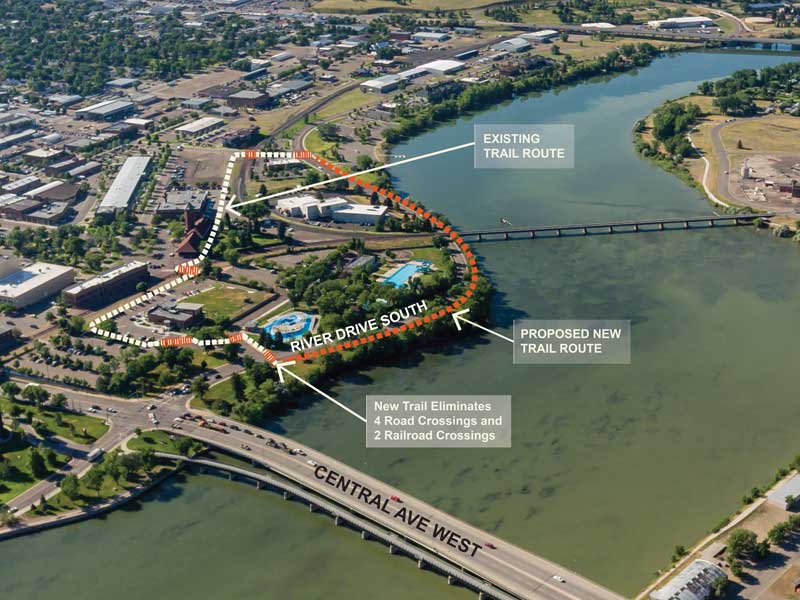
Project Overview
The Montana Department of Transportation (MDT) is proactively investing in safe, pedestrian-friendly infrastructure in Montana to reach its Vision Zero goal. River's Edge Trail Connector Project will provide a much-needed missing link in the River's Edge Trail system by constructing a pedestrian trail near the Missouri River in Great Falls along River Drive.
The River's Edge Trail Connector Project will move the River's Edge Trail from between Broadwater Bay and 1st Avenue to alongside the river. This project will replace the trail section that is highly confusing for users due to its route behind the police department and the water park. Moving the trail will improve safety for pedestrians and trail users, as the current section crosses busy streets and an active railway in two places. The proposed trail alignment along the edge of the river eliminates those crossings.
MDT is teaming up with the City of Great Falls, the River's Edge Trail Foundation, and TD&H Engineering to accomplish this important project.
Project Location

Proposed route of the River’s Edge Trail Connector. Image courtesy of LPW Architecture.
Click the image for a larger view
The trail will cross the north entrance to Broadwater Bay parking and boat ramp before traversing through the park. At the north end of the open park area, it will follow the edge of River Drive along the Missouri River. From the railroad bridge, the pathway will divert west and hug the bank of the river for approximately 300 feet. From the riverbank, the trail will turn away from the river and enter the park, where it will link up with the existing trail at a "T" intersection just south of Central Avenue West. The proposed new trail will be 10-feet wide with five-inch thick concrete surfacing.
Design Options
During the preliminary design process, MDT explored a variety of design options. Following a complete analysis of all options, three primary alternatives were selected. After reviewing environmental impacts, preferred engineering options, and total project expenses, Alternative One: Retaining Wall with Road Realignment shows clear advantages over the other alternatives considered. Reduced environmental impacts, decreased geotechnical engineering concerns and a more economical cost make Alternative One preferred.
Alternative One: Retaining Wall with Road Realignment (Preferred)
This option includes constructing a portion of the trail as a causeway with a retaining wall under the railroad bridge. The riverbank’s impact below the ordinary highwater mark would be less than 300 feet long. The trail will be next to the railroad bridge pier and slightly encroach into the river channel. This option includes the realignment of a portion of River Drive south of the railroad.
Alternative Two: Retaining Wall Only
This option keeps River Drive in its current location. Therefore, it would include a longer portion of the trail as a causeway along the riverbank in addition to a retaining wall under the railroad bridge. The retaining wall would be over 500 feet long, route next to the railroad bridge pier, and encroach on the river channel for a longer distance than Alternative One.
Alternative Three: Bridge
This option was reviewed for feasibility and involves building a bridge under the railroad bridge, along the riverbank under and around the railroad bridge pier. Portions of the bridge could be a cantilevered structure. This option is more costly, difficult to construct, and requires more maintenance than the other two options.
Engineer to English
Causeway: a trail, roadway, or railroad track located on the upper point of an embankment that crosses a body of water.
Cantilever: a rigid structural element that extends horizontally and is supported at only one end. A wall or other horizontal surface serves as its anchor, and it must be secured firmly. Like other structural elements, a cantilever can be formed as a beam, plate, truss, or slab.
Public Involvement
In addition to seeking general public comment on the project, MDT also seeks public comment on each specific design alternative. Those wishing to comment on the project should contact Ella Currier at



